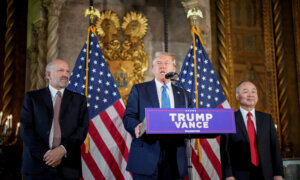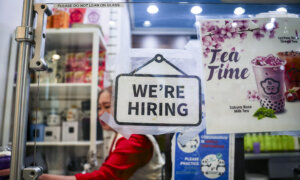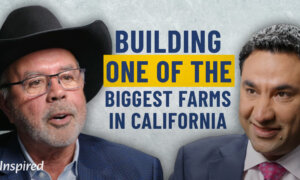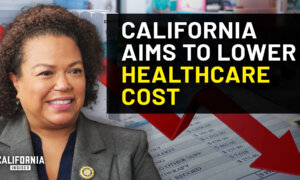The Federal Reserve has cut interest rates for the first time in four years after concluding its two-day policy meeting on Sept. 18.
Monetary policymakers kicked off their first easing campaign since the onset of the COVID-19 pandemic by lowering the benchmark federal funds rate by 50 basis points, to a range of between 4.75 percent and 5 percent. The decision affects interest rates on credit cards, auto loans, mortgages, and other financial products, as well as savings accounts.
The central bank’s decision to drastically lower interest rates just ahead of November’s presidential election is expected to draw some criticism.
Former President Donald Trump, for example, told Bloomberg in May that the Fed’s move to lower rates is “something that they know they shouldn’t be doing” so close to an election.
However, investors had widely expected that the central bank would start the new cycle in an aggressive manner.
“The committee has gained greater confidence that inflation is moving sustainably toward 2 percent, and judges that the risks to achieving its employment and inflation goals are roughly in balance,” the post-meeting statement from the Federal Open Market Committee (FOMC) reads.
“The committee would be prepared to adjust the stance of monetary policy as appropriate if risks emerge that could impede the attainment of the committee’s goals.”
Meeting participants voted for the cut 11–1, with Gov. Michelle Bowman opting for a quarter-point reduction.
As for the broader economy, the Fed stated that recent indicators suggest that economic activity “continued to expand at a solid pace” and employment gains have slowed while the unemployment rate “remains low.”
“Inflation has made further progress toward the committee’s 2 percent objective, but remains somewhat elevated,” the statement reads.
Following the Fed’s announcement, President Joe Biden said on social media platform X: “We just reached an important moment: inflation and interest rates are falling while the economy remains strong.
“The critics said it couldn’t happen—but our policies are lowering costs and creating jobs.”
Is Inflation Fight Over?
Fed Chair Jerome Powell is not declaring victory on inflation just yet, because the primary focus still is keeping inflation stable and preventing the unemployment rate from climbing higher.“We’re trying to achieve a situation where we restore price stability without the kind of painful increase in unemployment that has come sometimes with disinflation,” Powell told reporters at the post-meeting press conference.
He also shrugged off criticisms that the Fed has been late to begin reducing interest rates.
“We don’t think we’re behind. We do not,” Powell said. “But I think you can take this as a sign of our commitment not to get behind.”
At the same time, the half-point cut does not indicate that this is the Fed’s new pace, he said.
“We can go quicker or slower or pause on rate cuts if it is appropriate,” Powell said.
When asked whether the economy will return to the pandemic-era ultra-low interest rates, he said his sense is that there will not be a return to that economic climate.
“Intuitively, most—many, many people anyway—would say we are probably not going back to that era where there were trillions of dollars of sovereign bonds trading at negative rates, long-term bonds trading at negative rates,” Powell said.
Summary of Economic Projections
According to the Summary of Economic Projections (SEP) released by the Fed after the meeting, Fed officials expect another 50 basis-point cut this year.Policymakers expect the median policy rate to be 4.4 percent by the end of the year, down from the June projection of 5.1 percent.
They forecast the median policy rate decreasing to 3.4 percent in 2025 and 2.9 percent in 2026. These predictions are down from the June SEP of 4.1 percent and 3.1 percent, respectively.
Change in the real gross domestic product growth rate was revised lower, from 2.1 percent to 2 percent this year. The Fed still predicts that the economy will grow at a modest 2 percent pace in 2025 and 2026.
It predicts that the unemployment rate will rise to 4.4 percent in 2024 and 2025 and dip to 4.3 percent in 2026. This is up from the previous expectations of 4 percent (2024), 4.2 percent (2025), and 4.1 percent (2026).
Inflation is also forecast to continue moderating.
The growth in the median personal consumption expenditures (PCE) price index—the Fed’s preferred inflation gauge—is anticipated to slow to 2.3 percent in 2024 and 2.1 percent in 2025. Growth in the core PCE, which excludes the volatile food and energy categories, is not expected to ease to 2 percent until 2026.
Market Reaction
U.S. stocks reacted favorably after the super-sized rate cut, with the leading benchmark indexes rising by as much as 0.9 percent.Short- and medium-term Treasury yields slipped, with the one-month yield tanking by more than 8 basis points, to below 4.85 percent. The benchmark 10-year yield held steady, gaining 2 basis points, to above 3.66 percent.
The U.S. dollar index, a gauge of the greenback against a basket of currencies, plummeted by nearly 0.5 percent to below 100.5.
“Equity markets applauded the Fed’s decision to initiate its easing cycle with 50 basis points, as the statement noted that the Fed’s dual mandates are in balance,” said Quincy Krosby, chief global strategist at LPL Financial.
The sizable rate cut was part of the central bank’s greater focus “on risks associated with risk management of labor conditions, as the statement noted that inflation has been moving towards the Fed’s target.”
The U.S. economy created a smaller-than-expected 142,000 new jobs in August, and the unemployment rate ticked lower to 4.2 percent.
Apollo Global Management’s chief economist, Torsten Slok, predicted that rates will reach 3 percent by the end of next year, “nearly double the average 1.8 percent rate over the past decade.”
“We believe that interest rates will remain relatively higher for longer,” he said in a note.
Nancy Tengler, CEO and chief investment officer at Laffer Tengler Investments, said that she thinks Powell “may have jumped the gun” with a half-point cut.
“My criticism of the Fed has been a myopic focus on backward-looking data. This feels like that,” she said.
According to Greg McBride, chief financial analyst at Bankrate, the Federal Reserve “is taking out some insurance against being behind the curve again.”
“An interest rate cut isn’t about pressing the gas and adding fuel to the economy but rather lifting the foot off the brake so interest rates aren’t as high and are less of a headwind on the economy,” he said.
A Brief History of Policy
At the onset of the COVID-19 pandemic, the Fed slashed interest rates to nearly zero percent and grew the money supply by about $6 trillion to help cushion the economic blows of the public health crisis.Officials initially dismissed inflationary pressures, calling them “transitory.” However, after it was revealed that inflation was proving to be a significant challenge for the U.S. economy, the central bank started tightening monetary policy in March 2022.
The Fed kicked off the cycle with a quarter-point increase to the policy rate on March 17, 2022. Policymakers followed up with 10 more rate hikes, raising the benchmark rate to a range of between 5.25 percent and 5.5 percent on July 26, 2023, the highest level in 23 years.
Monetary authorities left interest rates alone for more than a year, affording the central bank the luxury of waiting to determine whether inflation would sustainably return to the Fed’s target rate of 2 percent.
After some bumps in the road during the first quarter, price pressures subsided in the subsequent months. The annual inflation rate eased to 2.5 percent in August, the lowest reading since February 2021.
Recent trends—in inflation and the labor market—prompted Powell to deliver a speech that investors and economists had been waiting to hear.
“The time has come for policy to adjust,” the central bank chief said in his keynote address at the Jackson Hole Economic Symposium. “The direction of travel is clear, and the timing and pace of rate cuts will depend on incoming data, the evolving outlook, and the balance of risks.”
Looking ahead, the Fed has made clear that it will concentrate more on the labor side of the institution’s dual mandate of price stability and maximum employment.
Powell and his colleagues have acknowledged that the labor market has become more balanced.
“We do not seek or welcome further cooling in labor market conditions,” Powell said.














